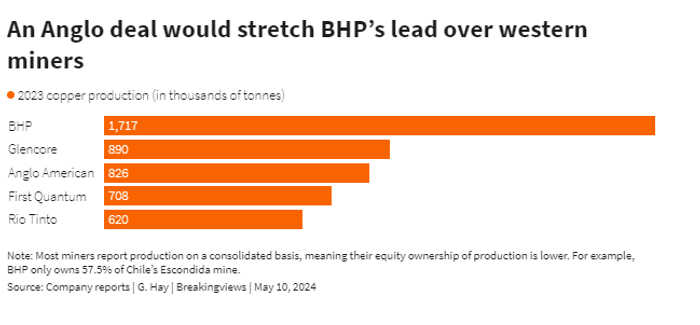Published 19:40 IST, May 10th 2024
Rio Tinto may be dark horse in BHP-Anglo saga
Glencore and Rio will have been eyeing Anglo’s 826,000 tonnes of consolidated 2023 copper production.
- Republic Business
- 3 min read

Great mines think alike. The world’s biggest miners are in the spotlight. Ever since Anglo American rejected last month’s $39 billion approach from $144 billion Australian rival BHP, a key worry has been whether $72 billion Glencore and $120 billion Rio Tinto will commence an expensive bidding war for the UK-listed group. Yet there’s scope for a less value-destructive outcome.
Glencore and Rio will have been eyeing Anglo’s 826,000 tonnes of consolidated 2023 copper production. A successful BHP bid would see the Big Australian’s own consolidated output exceed 2 million tonnes. That would make it easily the global leader in the energy transition’s key metal, way above Glencore’s 890,000 tonnes in 2023 and Rio’s 620,000 tonnes.
Glencore’s South African links and potential interest in domestic iron ore assets – which BHP doesn’t want – may make it a better fit with Anglo overall. At Rio, boss Jakob Stausholm could use more copper options beyond his flagship Oyu Tolgoi mine in Mongolia. He also has minimal net debt, and needs to offset a large exposure to iron ore, which contributes two-thirds of group EBITDA.
BHP’s move has certainly unleashed miners’ animal spirits, and it’s quite possible that Stausholm or Glencore boss Gary Nagle unveils an Anglo bid. But there are plenty of reasons not to. While CreditSights reckons Anglo’s copper arm alone may be worth $35 billion, the successful bidder risks paying a premium for other assets it doesn’t want. Anglo’s coal assets could hike the contribution from the pollutant in Glencore’s EBITDA, potentially making it hard for some investors to hold it. Rio is a particularly poor candidate for incaution – JPMorgan analysts reckon it has written $54 billion off the value of its balance sheet due to past M&A goofs since 2007, compared to BHP’s $33 billion.
One way to avoid harking back to these bad old days would be for Rio to hang back. Were BHP to win Anglo, it would be preoccupied with the integration for years. With Glencore needing to digest its $6.9 billion Teck coal deal, Rio may be able to look at other targets unimpeded. Canada’s $11 billion First Quantum comes with 700,000 tonnes of annual copper production, while Teck’s newly separate metals business could produce 500,000 tonnes in 2024.
These sorts of alternatives wouldn’t exactly be strife-free. First Quantum’s market capitalisation has nearly doubled since December, and bidders would have to pay meaningful control premiums beyond that. Meanwhile a big chunk of the Canadian miner’s annual potential copper output is the Cobre mine in Panama, which is currently shuttered by the domestic government.
Still, the country just elected a new leader who may be more amenable to a compromise. First Quantum and Rio also both count Chinese miners as major investors, and factoring in Rio’s own growth a deal could boost Stausholm’s headline annual copper output to 1.5 million tonnes. If he can see a way to do that without getting embroiled in a bidding war, his mining giant may take the plunge.

Updated 19:40 IST, May 10th 2024